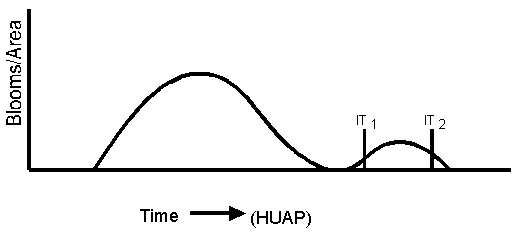Management Factors Associated with Fiber Micronaire
by Jeffrey C. Silvertooth,
Extension Agronomist - Cotton
In recent editions of this article I have addressed several aspects associated with fiber micronaire in Arizona Upland cotton. It is apparent that a distinct trend exists with increasing micronaire values for Arizona cotton since 1993. At the same time, lint yields have experienced somewhat of a plateau. A similar trend with respect to both micronaire and yield exists for the entire U.S. cotton belt. The three most dominant factors associated with fiber micronaire include 1) genetics, 2) environment (climate), and 3) management. In general, the management objectives I would describe in achieving optimum yields and micronaire are the same as those for realizing early maturity (earliness). In this article I will review selected crop management practices that can have a significant impact on fiber micronaire.
The timing of the final irrigation (i.e. irrigation termination) can impact yield and fiber micronaire. At the end of the first fruiting cycle (Figure 1), when the nodes above the top (first position) white flower (NAWF) are 5 or less, the decision needs to be made as to whether the bolls from the first fruiting cycle will be sufficient for the crop to harvest or if a second fruiting cycle (top-crop) will be attempted. If the second fruiting cycle is attempted, an extra six to eight weeks of production time may be needed to realize the full development and maturation of the top-crop. If a sufficient boll load is set through the second fruiting cycle the grower benefits from additional yield. Additionally, fiber in the upper portions of the plant is often has lower micronaire than bolls on the lower portion of the plant. Thus, as the fiber from both portions of the plant is blended, more optimal average micronaire values can be realized.
However, if a substantial boll load is not developed from the top-crop, the additional production time serves to fully mature all the existing bolls from the first fruiting cycle, which includes bringing the micronaire values closer (higher) to their maximum potential. This may be a contributing factor to many of the high micronaire problems recently encountered in Arizona.
The data in Figure 2 illustrates this trend from
a study that was conducted with DP NuCotn 33B at Maricopa, AZ comparing
three dates of final irrigation. For this experiment, planting was on
9 April and the end of the first fruiting cycle (cut-out) occurred in
the first week of August. The treatments consisted of irrigation termination
(IT) on 7 August, 20 August, 17 September. The first IT date (7 August)
provided soil moisture on this sandy loam soil sufficient only to mature
the blooms that were set the first week of August. The second IT date
(20 August) provided one additional irrigation that could be considered
as "insurance" to mature the existing fruit load. The final
IT date (17 September) was intended to support growth through the top-crop
and these plots had also received the 20 August irrigation and some rainfall
in late August and early September. Each treatment was defoliated approximately
25-30 days after the final irrigation. For more details on this study
see the
article on page 34 of the 1998 UA Cotton Report, Series P-112.
As shown in Figure 2, the trends indicated an increase in fiber micronaire with later IT. Yields were good for all treatments, but also tended to increase with later IT. This is certainly not offered as an absolute antidote to the recent problems Arizona has experienced with high micronaire and associated discounts. But, these trends may be important in relation to the impact that management can have on fiber micronaire. One thing is clear, we obviously have a lot to learn in an effort to understand how crop management effects fiber micronaire.
Figure 1. General cotton fruiting cycle with two hypothetical irrigation termination (IT) points.
Figure 2. Irrigation termination treatment effects on yield and micronaire, Maricopa, AZ, 1997. [Variety = DP 33b, date of planting = 9 April, and cut-out was evident on 4 August 1997]
Issued in furtherance of Cooperative Extension work, acts of May 8 and June 30, 1914, in cooperation with the U.S. Department of Agriculture, James A. Christenson, Director Cooperative Extension, College of Agriculture and Life Sciences, The University of Arizona.
The University of Arizona is an equal opportunity, affirmative action institution. The University does not discriminate on the basis of race, color, religion, sex, national origin, age, disability, veteran status, or sexual orientation in its programs and activities.
Any products, services, or organizations that are
mentioned, shown, or indirectly implied in this web document do not imply
endorsement by The University of Arizona.
Information provided by Jeffrey C. Silvertooth, silver@ag.arizona.edu
Extension Agronomist - Cotton, College of Agriculture, The University of Arizona.
Material written 6 May 2000.
Home | Cotton | Advisories
document located at: http://cals.arizona.edu/crops/cotton/comments/may2000cc.html
Copyright © 2001 University of Arizona,
College of Agriculture and Life Sciences
Webmaster: Al Fournier (acis@ag.arizona.edu)

![Figure 2. Irrigation termination treatment effects on
yield and micronaire, Maricopa, AZ, 1997. [Variety = DP 33b, date of planting
= 9 April, and cut-out was evident on 4 August 1997]](images/may002.gif)